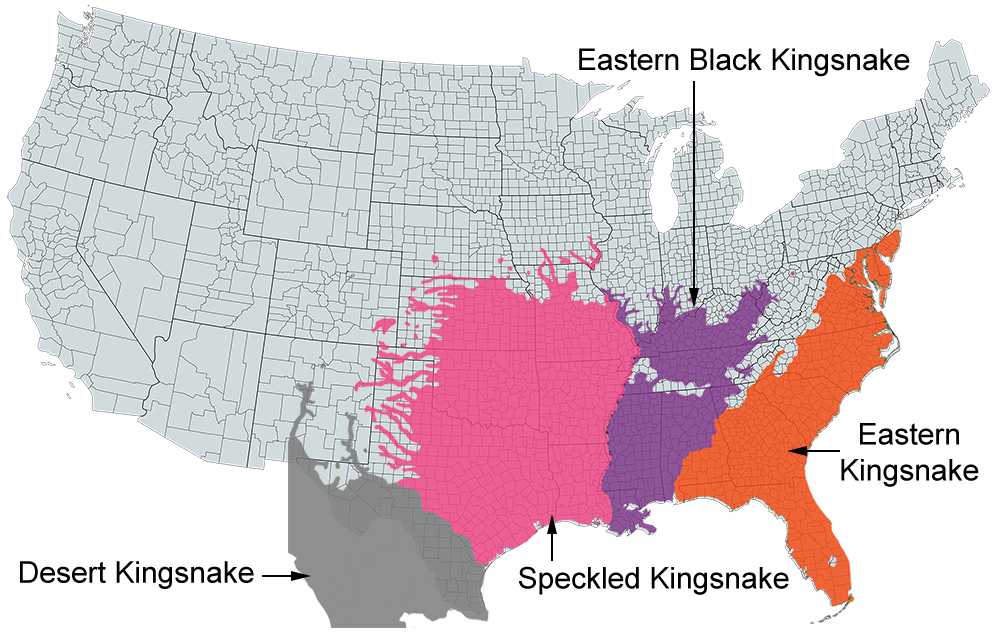Eastern Black Kingsnake
Lampropeltis nigra
** Harmless **
Common Name: |
Eastern Black Kingsnake |
Scientific Name: |
Lampropeltis nigra |
Etymology: |
|
Genus: |
Lampropeltis is derived from the Greek words lampros which means "radiant" and pelta meaning "small shields". |
Species: |
nigra is derived from the Latin word niger which means "black". |
Vernacular Names: |
Black snake, chain snake, mole snake, Ridgway's king snake, thunder snake. |
Average Length: |
36 - 45 in. (90 - 114 cm) |
Virginia Record Length: |
|
Record length: |
58 in. (147.3 cm) |
Systematics:
Description: A large, stout snake reaching a maximum total length of 2,083 mm (82.0 inches) (Conant and Collins, 1991). In Virginia, maximum known snout-vent length (SVL) is 1,456 mm (57.3 inches) and maximum total length is 1,621 mm (63.8 inches). In this study, tail length/total length was 9.1-14.5% (ave. = 11.8 ± 1.3, n = 82).
Scutellation: Ventrals 191-220 (ave. = 209.6 ± 4.4, n = 108); subcaudals 20-54 (ave. = 44.7 ± 5.0, n = 102); ventrals + subcaudals 230-268 (ave. = 254.3 ± 7.2, n = 102); dorsal scales smooth, scale rows usually 21 (89.9%, n = 79) at midbody, or maybe 20,22, or 23 (10.1%); anal plate undivided; infralabials 9/9 (78.8%, n = 99) or other combinations of 8-10 (21.2%); supralabials 7/7 (88.7%, n = 97) or other combinations of 6-8 (11.3%); loreal scale present; preoculars 1/1; postoculars 2/2; temporal scales usually 2+3/2+3 (85.0%, n = 94) or other combinations of 2-4 (15.0%).
Coloration and Pattern: Dorsal body color black with a series of 18-39 (ave. = 26.2 ± 4.2, n = 93) thin white to yellow crossbars (0.5-2.0 scales wide) or with an irregular number of small white to yellow spots; if crossbars present, most divide on sides at about scale row 5 and arms often connect with irregular white to yellow ventrolateral patches; crossbars often incomplete or broken, and lateral bifurcations may not be present; crossbars on tail not divided, and usually connect with ventrolateral patches; venter black with continuations of ventrolateral patches forming a highly irregular, alternating series of black-and-white patches, or venter black with small yellowish spots; ventral pattern sometimes faded and may be obscure; head black with varying numbers of white or yellow spots; infralabials and supralabials white to yellow and bordered in black. The head is not distinct from the neck and is small.
Lampropeltis nigra is characterized by having much-reduced white to yellow pigment. The dorsum is nearly all black with a variable number of small yellow spots. Crossbars are generally lacking, but the yellow spots in some individuals, especially juveniles and immatures, may form a visible chain pattern. Yellow spots occur on the ventrolateral region, and the yellow on the venter occurs as spots or as irregular patches covering 1-2 scales. The venter is darker posteriorly. The head is black with small yellow spots. The chin and labial scales are yellow and the labials are outlined in black.
Sexual Dimorphism: Adult males (635-1,456 mm SVL, ave. = 1,036.9 ± 206.3, n = 37) were larger than adult females (660-1,291 mm SVL, ave.= 921.7 ± 157.4, n = 27). Sexual dimorphism index was -0.12. The average numbers of ventrals were nearly identical (males 209.3 ± 4.6, 191-218, n = 56; females 209.9 ± 3.9,199-215, n = 49), but the number of subcaudals was higher in males (34- 54, ave. = 46.9 ± 4.4, n = 54) than in females (20- 51, ave. = 42.1 ± 4.5, n = 46). Consequently, the average number of ventrals + subcaudals was slightly higher in males (255.7 ± 7.8, 231-268, n = 54) than in females (252.3 ± 6.0, 230-264, n = 46). There were no substantial differences between sexes in tail length/total length (males 12.1 ± 1.3%, 9.1-14.5, n = 46; females 11.4 ± 1.2%, 9.5- 14.2, n = 34) and number of crossbands (males 26.3 ± 4.0,19-34, n = 50; females 26.2 ± 4.5,18- 39, n = 40).
Juveniles: Juveniles of L. nigra have thin crossbars and irregular lateral spotting. The bifurcations of the crossbars are usually not present, nor are the ventrolateral patches. The juvenile dorsal pattern apparently breaks up with age in Virginia L. nigra as it does in some other areas (Blaney, 1977). At hatching, juveniles were 208-277 mm SVL (ave. = 244.6 ± 21.9, n = 33), 238- 317 mm total length (ave. = 280.2 ± 25.1, n = 32), and 6.3-9.1 g body mass (ave. = 8.1 ± 1.6, based on means of 3 litters).
Confusing Species: The only other black snakes in Virginia are Coluber constrictor and Pantherophis alleghaniensis. Neither of these species has white or yellow crossbars or spotting on the head and venter; both have a uniformly black to gray black dorsum. The dorsum of Pantherophis alleghaniensis may show a narrowly defined blotched pattern in some snakes, especially in southwestern Virginia, but the lateral white to yellow pigment is lacking. Juveniles of these snakes have a series of brown blotches on a gray dorsum.
Geographic Variation: The L. nigra pattern is confined to the southwestern corner of Virginia. Scutellation in L. nigra was within the range of variation exhibited by L. getula in number of ventrals (nigra 203.0 ± 1.4, 202-205, n = 4; getula 209.8 ± 4.4,191-220, n = 106), number of subcaudals(nigra 49.3 ±2.1,47-51, n = 3; getula 44.9 ± 4.4, 34-54, n = 99), and number of ventrals + subcaudals (nigra 252.7 ± 1.2, 252-254, n = 3; getula 254.6 ± 6.9, 230-268, n = 99).
References for Life History
Photos:
*Click on a thumbnail for a larger version.
Verified County/City Occurrence in Virginia
Lee
Scott
Washington
CITIES
Verified in 3 counties and 0 cities.
U.S. Range

US range map based on work done by The Center for North American Herpetology (cnah.org) and Travis W. Taggart.







